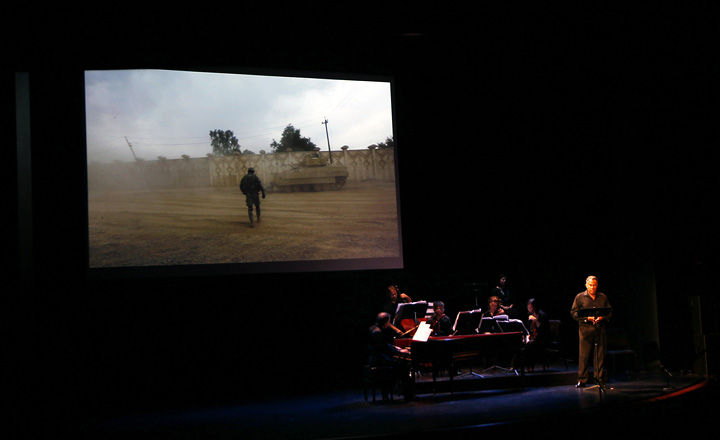Sound+Vision
Sound+Vision: At War Photographs from Iraq and Afghanistan by Chris Hondros Music of Johann Sebastian Bach Fusion Bande; Kenneth Hamrick, Artistic Director Gerald W. Lynch Theater at John Jay College, New York, NY September 29, 2010According to American Pulitzer Prize-nominated photojournalist Chris Hondros, “Bach’s meditations on emotion and loss seamlessly apply to war, whether fought in the 18th century or the 21st…the human experience of war has changed little over the centuries.” As I viewed revelatory, disturbing and often poignant photographs of soldiers and civilians while listening to live music of Johann Sebastian Bach, I agreed totally with that sentiment; I highly recommend this multi-media presentation.
The counterpoint in Bach’s music fits perfectly with the chaos and internal struggles of Iraq and Afghanistan, and the gentle strands of melody in less complex music draws one into the deeply personal reactions of all the individuals on screen. The panel discussion, which followed the presentation, brought personal experiences into greater light, as journalists, educators, an Iraqi war veteran, and Hondros himself discussed their thoughts about the war and answered the audience’s questions. Hondros takes startlingly beautiful, clear photographs that were practically three-dimensional on the Getty Images screen. The expressions on the many faces were heart-wrenchingly multi-dimensional as well; one could see combinations of shock, horror, pain, hate, hope and even love.
I felt almost present on the battlefield, the streets, in the hospital or in the school yard. Surprisingly, there were many joyful images—touching hints of what a free Iraq has become or will be. One memorable section showed the citizens’ delight with fresh, running water, seemingly symbolic of their newfound freedom. The photographs of Iraqi children with American soldiers showed the great contrast between intimidation and innocence. A stand-out performer in Fusion Banda was double bassist Andrew Trombley. The solo baritone Anthony Turner and the soprano Amanda Papuan were very good. Harpsichordist and Director Kenneth Hamrick did a fine job with coordination, but violinist Jerry Chiu had an edgy sound and approximate intonation.
Bach’s 18th century music—opposed to Shostakovich’s 20th century, military-like music, for example— is a great choice, as it does mirror the antiquity and sacred nature of the Middle East countries. His counterpoint (several melodic lines at once) in turn represents the complexities and struggle of war, while sustaining an ironic tonality—seemingly symbolizing the goals of resolution and peace. This is a great concept and a marvelous presentation which should tour the US, and perhaps even Iraq and Afghanistan.

